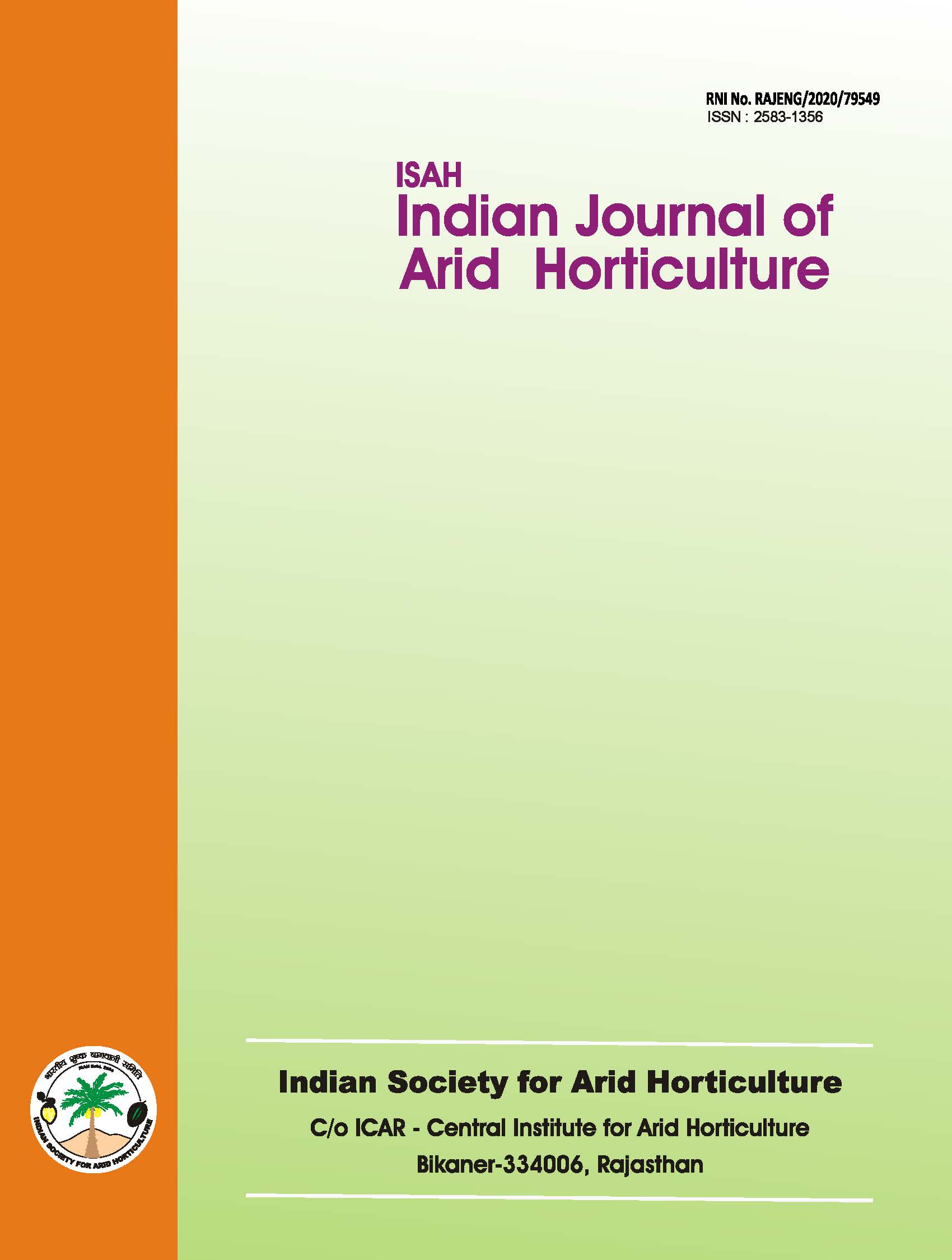Optimizing guava (Psidium guajava L.) breeding programs: The role of genotype selection in enhancing growth, yield and nutrient content
DOI:
https://doi.org/10.48165/ijah.2025.7.1.5Keywords:
Guava, genetic variability, cross combination, yieldAbstract
This study examines genetic variation and its impact on key growth, yield, and quality traits in guava genotypes through analysis of variance and per se performance of cross combinations. The results indicate significant genetic effects on most traits, with the highest variations observed for days to first flowering (DTFF), days to first harvest (DTFH), number of seeds per fruit (NSPF), total phenols (TPH), and total antioxidant activity (TAA), highlighting the potential for selection based on these traits. The study also identifies traits with lower genetic variability, such as acidity (Acid) and pulp thickness (PT), suggesting their dependence on environmental or management factors. The ANOVA results revealed significant impacts of genotypes on key traits related to growth, yield, and fruit quality, with extremely high F-values (p< 0.0001) for most traits, suggesting that genotype plays a dominant role in the expression of these characteristics. Notably, the cross combinations, including G-28 × Lalit and G-15 × VL, showed strong potential for improving growth and quality parameters. G-28 × Lalit demonstrated superior growth and nutrient content, while G-15 × VL excelled in quality traits such as sugar content, total soluble solids (TSS), and antioxidant properties. Additionally, other cross combinations like VL × G-15 and G-31 × TP offered promising results for increasing biomass, yield, and fruit quality. Further multi-generational evaluations and environmental studies are essential to assess the stability and heritability of these traits under diverse conditions. The study highlights the importance of genotype selection for developing high-performing guava cultivars, emphasizing the need for further research to optimize breeding strategies for improved yield, quality, and resilience.
Downloads
References
Azam, M.G., Uddin, M.S., Chowdhary, S.M.K., Rashid, Hasan, Harunor, A.S.M., Barua, H., Chhanda, R.A., Rahman, S., Bagum, S.A., Shamsunnahar, M., Islam, M.N. 2020. Variability studies of guava (Psidium guajava L.) genotypes for growth, yield and quality attributes in Chattogram region of Bangladesh. Journal of Agricultural Science & Engineering Innovation (JASEI), 1(2): 3-9.
Badami, K., Daryono, B. S., Amzeri, A. and Khoiri, S. 2020. Combining ability and heterotic studies on hybrid melon (Cucumis melo L.) populations for fruit yield and quality traits. SABRAO Journal of Breeding and Genetics, 52(4): 402-417.
Bishnoi, P., Thakre, M., Maurya, P., Jagga, S., Gangappa, N. D., Nagaraja, A., Verma, M.K., Krishnan, S.G., Varghese, E. and Mithra Sevanthi, A. 2024. Pulp colour and pigment composition have no genetic correlation with seed hardness in guava (Psidium guajava L.). The Journal of Horticultural Science and Biotechnology, 1-14. https://doi.org/10.1080/14620316.2024.2392090
Bose, S. K., Ahmed, S., Howlader, P. and Ali, M. 2019. Flowering, fruiting behavior and nutritional quality of selected guava genotypes. International Journal of Horticultural Science and Technology, 6(1): 11-25.
Chiveu, J., Naumann, M., Kehlenbeck, K. and Pawelzik, E. 2019. Variation in fruit chemical and mineral composition of Kenyan guava (Psidium guajava L.): Inferences from climatic conditions, and fruit morphological traits. Journal of Applied Botany and Food Quality, 92: 151–159.
Correa, L.C., Santos, C.A.F. and Lima, G.P.P. 2012. Chemical and biochemical characterization of guava and araca fruits from different regions of Brazil. Acta Horticulturae, 959: 103-109.
Kamath, J. V., Rahul, N., Kumar, C. A. and Lakshmi, S. M. 2008. Psidium guajava L: A review. International Journal of Green Pharmacy, 2(1): 9-12. https://doi.org/10.4103/0973-8258.39155
Kherwar, D. and Usha, K. 2016. Genetic variations, character association and path analysis studies in guava (Psidium guajava L.) for bioactive and antioxidant attributes. Indian Journal of Plant Physiology, 21: 355-361.
Kumari, P., Mankar, A., Karuna, K., Homa, F., Meiramkulova, K. and Siddiqui, M. W. 2020. Mineral composition, pigments, and postharvest quality of guava cultivars commercially grown in India. Journal of Agriculture and Food Research, 2: 100061. https://doi.org/10.1016/j.jafr.2020.100061
Kumari, S., Arumugam, N., Singh, R., Srivastav, M., Banoth, S., Mithra, A.C., Arun, M.B., Goswam, A.K. and Khan, Y.J. 2018. Diversity analysis of guava (Psidium guajava) germplasm collection. Indian Journal of Agricultural Sciences, 88(3): 489-497.
Mishra, D. S., Berwal, M. K., Singh, A., Singh, A. K., Rao, V. A., Yadav, V. and Sharma, B. D. 2022. Phenotypic diversity for fruit quality traits and bioactive compounds in red-fleshed guava: Insights from multivariate analyses and machine learning algorithms. South African Journal of Botany, 149: 591-603.
Mishra, D.S. and Singh, A.K. 2022. Crop regulation in guava: a review. Annals of Arid Zone, 61(2): 75-82.
Mishra, D.S., Singh, A.K. and Rane, J. 2024. Guava breeding for future challenges. In: Dwibedi et al. (Eds.), Frontiers in Horticultural Technologies, Daya Publishing House, New Delhi. Pp. 87-112.
Mishra, D.S., Singh, S., Singh, A.K., Appa Rao, V.V. and Saroj, P.L. 2019. Assessment of genetic diversity in guava. Indian Journal of Horticulture, 75(3): 362-368.
Nakasone, H.Y. and Paull, R.E. 1999. Tropical fruits. Crop production in Science in Horticulture. CAB International, Wallingford, UK. P. 159.
Naseer, S., Hussain, S., Naeem, N., Pervaiz, M. and Rahman, M. 2018. The phytochemistry and medicinal value of (Psidium guajava) guava. Clinical Phytoscience, 4: 32-34. https://doi.org/10.1186/s40816-018-0093-8
Paras, Kaur, K., Kaur, G., Singh, D. and Brar, J. S. 2024. Heritability and principal component analysis of phytochemical traits in guava under Indian subtropics. Applied Fruit Science, 66(1): 193-202.
Pathak, R.K. and Ojha, C.M. 1993. Genetic resources of guava. In: Chadha, K.L., Pareek, O.P. (Eds.), Advance in Horticulture. Fruit Crops, Part 1, vol. I. Malhotra Publishing House, New Delhi. Pp. 143-147.
Pommer, C.V. 2012. Guava world-wide breeding: major techniques and cultivars and future challenges. Acta Horticulturae, 959: 81-88.
Sarkar, T. and Sarkar, S.K. 2022. Pollination characteristics and intervarietal hybridization of Psidium guajava. Journal of Crop and Weed, 18(1): 96-103.
Shukla, S., Kushwaha, R., Singh, M., Saroj, R., Puranik, V., Agarwal, R. and Kaur, D. 2021. Quantification of bioactive compounds in guava at different ripening stages. Food Research, 5(3): 183-189. https://doi.org/10.26656/fr.2017.5(3).554
Singh, D., Gill, M. I. S., Boora, R. S. and Arora, N. K. 2015. Estimates of genetic variability, heritability, genetic advance, correlation coefficients and their prospects for crop improvement in guava (Psidium guajava L.). Journal of Applied Horticulture, 17(1): 76-78.
Singh, R. and Sehgal, O.P. 1968. Studies on blossom biology of Psidium guajava L. (guava). II. Pollen studies, stigma receptivity, pollen and fruit set. Indian Journal of Horticulture, 25: 52-59.
Speer, H., D’Cunha, N. M., Alexopoulos, N. I., McKune, A. J. and Naumovski, N. 2020. Anthocyanins and human health—a focus on oxidative stress, inflammation and disease. Antioxidants, 9(5): 366. https://doi.org/10.3390/antiox9050366
Thakre, M., Hanamant, S., Ramkumar, M. K., Senapati, R., Rudra, S. G., Saha, S., Nagaraja, A., Verma, M. K., Krishnan, G. S., Varghese, E. and Amitha Mithra, S. V. 2023. Pigment composition analysis of fruit pulp in the recombinant progenies reveals the polygenic nature of pulp color inheritance in guava (Psidium guajava L.). Tree Genetics and Genomes, 19: 20. https://doi.org/10.1007/s11295-023-01595-w
Tripathi, P.C., Sane, A., Kumar, P, Kanupriya, C., Mishra, D.S. and Ravat, P. 2025. Phenotypic and genetic characterization of Cordia myxa L. using multivariate analysis. Flora, 323: 15263. https://doi.org/10.1016/j.flora.2025.152673
Woodside, J. V., McGrath, A. J., Lyner, N. and McKinley, M. C. 2015. Carotenoids and health in older people. Maturitas, 80(1): 63-68. https://doi.org/10.1016/j.maturitas.2014.10.012

